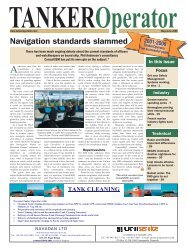Features: - Tanker Operator
Features: - Tanker Operator
Features: - Tanker Operator
You also want an ePaper? Increase the reach of your titles
YUMPU automatically turns print PDFs into web optimized ePapers that Google loves.
TECHNOLOGY - FOULINGS<br />
An idle ship is the<br />
devil’s playground<br />
The economic slow-down has resulted record breaking amount of ships at anchor<br />
and a speed-up of organisms attaching themselves to their hulls.<br />
Alarge percent of anchored ships<br />
are in warm Asian waters with<br />
known high level of ‘fouling<br />
pressure’ activity from the<br />
standpoint of slime, and marine growth.<br />
Performance losses, just due to light growth<br />
an inactivation of the coating system or<br />
inability to ‘foul release’ can result in an<br />
Aframax losing six tonnes per day ($2,700 per<br />
day).<br />
The concern from a scientific and industry<br />
standpoint is that the accumulation of fouling<br />
will cause an inactivation of the anti-fouling<br />
properties for biocide hull coatings. For foul<br />
release coatings, the possibility of slime and<br />
marine growth accumulation is exacerbated by<br />
their non-biocide nature.<br />
The local diving contractors in proximity to<br />
these anchored vessels will no doubt have<br />
some good business in the future when these<br />
ships return to service (assuming Port States<br />
allow underwater cleanings) but what are the<br />
consequences of not cleaning hulls and<br />
propellers in a timely manner, ie before<br />
sailing again?<br />
According to Daniel Kane, Propulsion<br />
Dynamics vice president; “From the<br />
standpoint of ship technical performance,<br />
there are robust formulas to calculate the<br />
ship’s added resistance while sailing, however,<br />
no formulas to work with in order to<br />
Increase of resistance<br />
Source: Propulsion Dynamics.<br />
determine the increase in hull resistance of<br />
idling ships.<br />
“Factors such as age of ship, time since last<br />
docking, type of coating, underwater surface<br />
area, and duration at anchor will all result in<br />
various degrees of fouling and resistance. Then<br />
additional factors while underway (speed and<br />
loading conditions) are factors that will make it<br />
impossible to determine which ships need<br />
husbandry and which ships will recover their<br />
fuel efficiency prior to anchoring. In other<br />
words, which ships with anti-foulants will have<br />
deactivated antifoulant and which ships with<br />
foul release will be unable to wash away the<br />
fouling is yet to be seen.<br />
“The astute shipowner will at minimum<br />
polish the propeller and at the same time order<br />
an in water hull inspection prior to departure,<br />
other shipowners will simply sail and observe<br />
the speed and fuel losses in order to schedule<br />
husbandry (if needed) at the next port of call,<br />
but the latter may mean wasted bunkers.<br />
“Of the hundreds of ships in our<br />
programme, we do have several dozen that are<br />
at anchor until further notice. We look<br />
forward to observing the changes in resistance<br />
of these ships when they lift anchor and<br />
eventually do sail. Our CASPER® service<br />
will benefit customers by working closely<br />
with them to assess fouling effect on fuel<br />
efficiency and mitigate fuel losses in the most<br />
60%<br />
55%<br />
50%<br />
45%<br />
40%<br />
35%<br />
30%<br />
25%<br />
20%<br />
15%<br />
10%<br />
5%<br />
0%<br />
2910 2930 2950 2970 2990 3010 3030 3050 3070 3090 3110 3130 3150 3170 3190<br />
Days for development of added resistance<br />
timely and appropriate manner,” he concluded.<br />
For ships in long layup periods, docking<br />
may be needed, according to other experts.<br />
Below is an example of the dramatic<br />
increase in hull and propeller resistance for a<br />
ship that was at anchor for only four weeks<br />
off the coast of West Africa. The x-axis<br />
represents the time in days (2,940 days since<br />
delivery). The last set of performance data<br />
was received on ‘Day 3,130.25’ the ship then<br />
anchored until we received the next set of<br />
performance data on ‘Day 3,155’.<br />
The resistance of the ship increased 30%<br />
which is normal for an older tanker to 52%,<br />
which for this ship represented a 0.9 knot loss<br />
in speed at 85% MCR. The resistance then<br />
climbed steadily indicating that the antifoulant<br />
had been inactivated by the marine<br />
growth. These cases are not common because<br />
today’s hull coating systems are doing a<br />
terrific job, but with thousands of ships at<br />
anchor now, these cases will be more<br />
common.<br />
According to Daniel Kane: “Let’s look at<br />
some numbers again, assuming the following<br />
ship types are at anchor for only a few months<br />
and then sail at design speed and draft. The<br />
Aframax tanker at six tonnes per day ($2,700<br />
per day) was just due to light growth an<br />
inactivation of the coating system, or inability<br />
to ‘foul release’. A conservative pay back<br />
time for hull and propeller cleanings varies<br />
from a few months for smaller ships and as<br />
little as two weeks for larger ships!<br />
These figures shed light on why hull and<br />
propeller performance monitoring are key<br />
areas of the Ship Energy Efficiency<br />
Management Plan (SEEMP) drafted by IMO<br />
in order to increase awareness of fuel<br />
conservation measures. This means that CO2<br />
reductions, when a part of reduction in fuel<br />
consumption is achieved at a negative cost per<br />
tonne of CO2 avoided.<br />
In the future, more and more focus will be<br />
on the biological risk of hull fouling, and<br />
integration of reducing biorisk whilst<br />
simultaneously improving fuel efficiency, “<br />
Kane said.<br />
TO<br />
November/December 2009 TANKER<strong>Operator</strong> 55

















